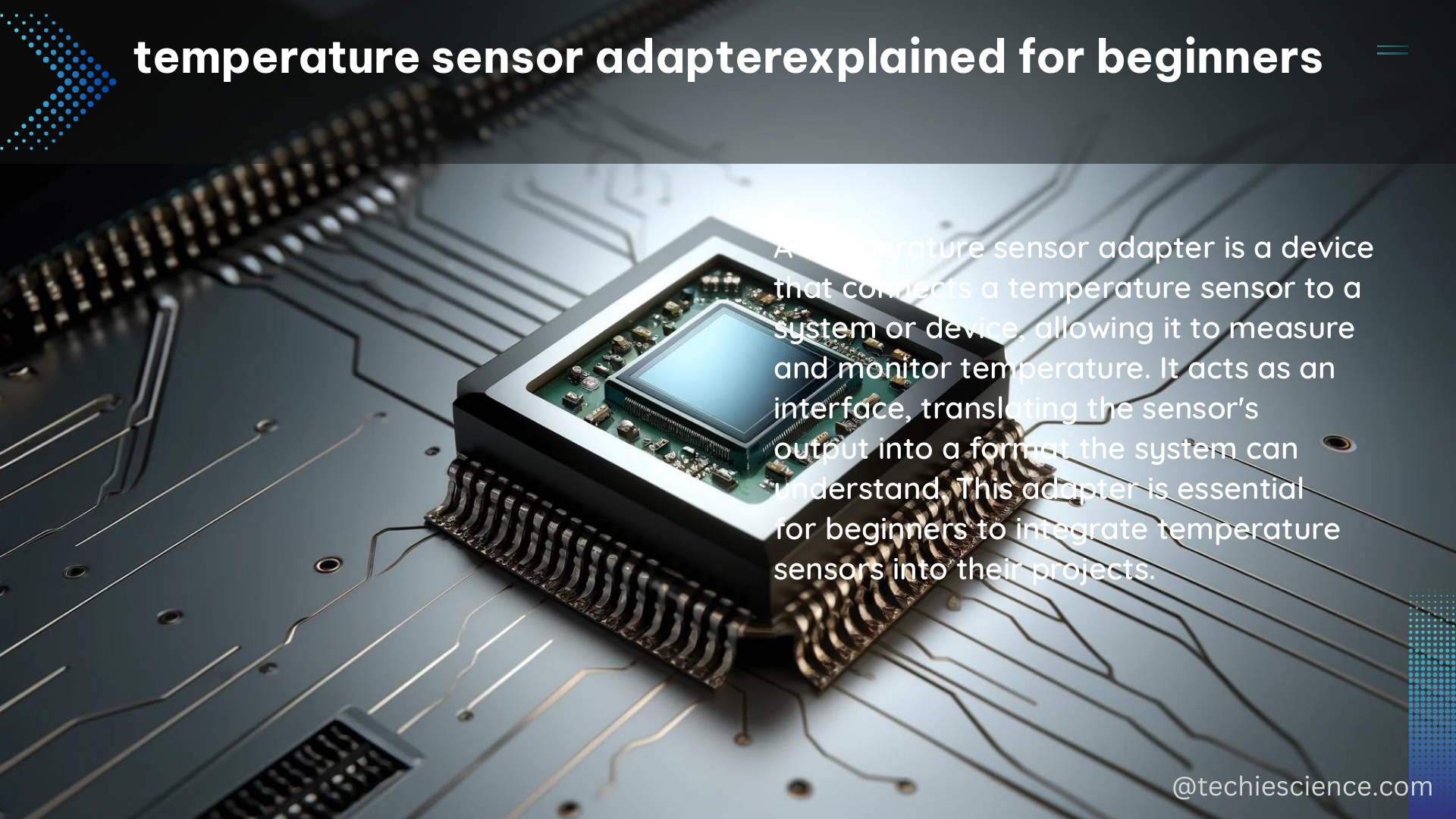Temperature sensor adapters are crucial components in temperature measurement systems, allowing for the connection and communication between temperature sensors and data acquisition systems (DAQs). This comprehensive guide will delve into the basics, technical specifications, and a DIY approach to temperature sensor adapters, providing a detailed and practical resource for beginners.
Basic Understanding and Types of Temperature Sensors
Temperature sensors are devices that convert temperature into an electrical signal, which can be measured and analyzed. The three main types of temperature sensors are thermocouples, RTDs (Resistance Temperature Detectors), and thermistors.
-
Thermocouples: These sensors consist of two dissimilar metal wires joined at one end, creating a voltage proportional to the temperature difference between the junction and a reference point. Thermocouples are known for their wide temperature range, ruggedness, and fast response time. They can measure temperatures from -200°C to 1,800°C with an accuracy of ±0.75% to ±2.2% of the reading.
-
RTDs: RTDs use a coil of fine wire, usually platinum, to measure temperature. The resistance of the wire changes with temperature, allowing for accurate and linear measurements. RTDs are praised for their high accuracy, stability, and repeatability. They can measure temperatures from -200°C to 850°C with an accuracy of ±0.1% to ±0.25% of the reading.
-
Thermistors: Thermistors are temperature-sensitive resistors made of ceramic or polymer materials. They offer high sensitivity and accuracy over a limited temperature range, typically from -100°C to 300°C, with an accuracy of ±0.1°C to ±0.5°C. Thermistors are commonly used in applications where high precision is required, such as medical devices and laboratory equipment.
Technical Specifications of Temperature Sensor Adapters

Temperature sensor adapters must meet specific technical requirements to ensure accurate and reliable temperature measurements. Key specifications include:
-
Input range: The adapter should support the temperature range of the connected sensor, whether it’s a thermocouple, RTD, or thermistor. For example, a thermocouple adapter should have an input range of -200°C to 1,800°C, while an RTD adapter should have an input range of -200°C to 850°C.
-
Accuracy: The adapter should have a high degree of accuracy to minimize measurement errors. Accuracy is typically specified as a percentage of the full-scale reading or in absolute terms. For instance, a thermocouple adapter may have an accuracy of ±0.25% of the reading, while an RTD adapter may have an accuracy of ±0.1% of the reading.
-
Linearity: Linearity refers to how closely the output of the adapter follows a straight line over its entire input range. High linearity, such as ±0.05% of the full scale, ensures more accurate measurements.
-
Response time: The adapter’s response time should match the sensor’s response time to capture rapid temperature changes accurately. Typical response times for temperature sensor adapters range from 10 milliseconds to 1 second, depending on the application.
-
Interfaces: The adapter should support the communication protocol used by the DAQ system, such as USB, Ethernet, or Wi-Fi. This allows for seamless integration and data transfer between the temperature sensor and the data acquisition system.
-
Power supply: The adapter should have a stable power supply to ensure accurate and consistent measurements. The power supply requirements may vary depending on the sensor type and the adapter’s complexity, ranging from 5V to 24V DC.
DIY Approach to Temperature Sensor Adapters
For those interested in a DIY approach, several resources are available online. Maker communities, such as Instructables and Hackster, offer projects and guides on building custom temperature sensor adapters using microcontrollers like Arduino or Raspberry Pi.
These DIY projects often involve the following steps:
-
Sensor Selection: Choose the appropriate temperature sensor (thermocouple, RTD, or thermistor) based on the required temperature range, accuracy, and response time.
-
Circuit Design: Design a circuit board that can interface the selected temperature sensor with the microcontroller. This may include signal conditioning, amplification, and analog-to-digital conversion.
-
Firmware Development: Write firmware for the microcontroller to read the sensor data, perform any necessary calculations or conversions, and communicate with the DAQ system.
-
Enclosure and Packaging: Design and 3D print or fabricate an enclosure to house the temperature sensor adapter, ensuring it is durable and easy to integrate with the DAQ system.
-
Calibration and Testing: Calibrate the temperature sensor adapter to ensure accurate measurements and test its performance under various temperature conditions.
By following these steps, beginners can create custom temperature sensor adapters that meet their specific requirements and integrate seamlessly with their data acquisition systems.
Conclusion
Temperature sensor adapters are essential components in temperature measurement systems, enabling the connection and communication between temperature sensors and data acquisition systems. Understanding the basics, technical specifications, and DIY approaches to temperature sensor adapters is crucial for beginners to successfully implement temperature measurement solutions in their projects.
References
- Dewesoft. (2023-08-30). How To Measure Temperature with RTD Sensors | Dewesoft. Retrieved from https://dewesoft.com/blog/measure-temperature-with-rtd-sensors/
- TheEngineeringMindset. (2019-07-11). Temperature Sensors Explained – YouTube. Retrieved from https://www.youtube.com/watch?v=w3Hfj2kMrGo
- TI. (n.d.). How to Read and Interpret Digital Temperature Sensor Output Data. Retrieved from https://www.ti.com/lit/an/sbaa588/sbaa588.pdf?ts=1713166373337
- PaulStoffregen. (2016-04-07). DS18B20 Temperature Sensor Tutorial – YouTube. Retrieved from https://www.youtube.com/watch?v=qxEclOy6jpI
- NI. (n.d.). Measuring Temperature with Thermocouples, RTDs, and Thermistors. Retrieved from https://www.ni.com/en-us/shop/data-acquisition/sensor-fundamentals/measuring-temperature-with-thermocouples-rtds-and-thermistors.html
- Instructables. (n.d.). Temperature Sensor Adapter Projects. Retrieved from https://www.instructables.com/search/?q=temperature+sensor+adapter&sort=relevance&qst=Temperature+Sensor+Adapter
- Hackster. (n.d.). Temperature Sensor Adapter Projects. Retrieved from https://www.hackster.io/search?q=temperature+sensor+adapter&sort=relevance&qst=Temperature+Sensor+Adapter

The lambdageeks.com Core SME Team is a group of experienced subject matter experts from diverse scientific and technical fields including Physics, Chemistry, Technology,Electronics & Electrical Engineering, Automotive, Mechanical Engineering. Our team collaborates to create high-quality, well-researched articles on a wide range of science and technology topics for the lambdageeks.com website.
All Our Senior SME are having more than 7 Years of experience in the respective fields . They are either Working Industry Professionals or assocaited With different Universities. Refer Our Authors Page to get to know About our Core SMEs.